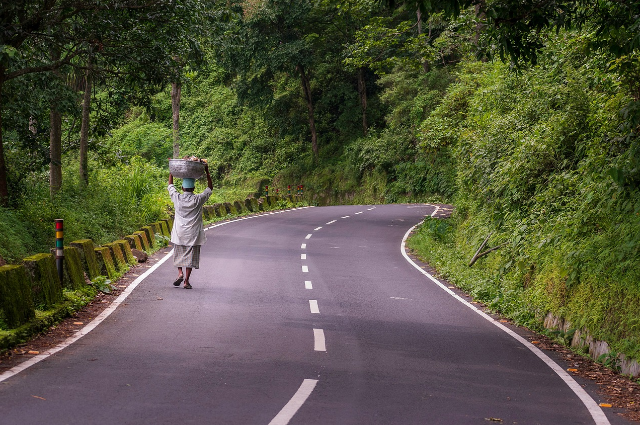
The tribal community residing in Madrebu village located in the Anantgiri Mandal of Visakhapatnam district, recently staged a protest demanding better road facilities. Travelling on horses through the forests, they highlighted their plight and warned of boycotting the upcoming elections if their transportation needs were not addressed. Despite claims of significant funds allocated for Adivasi development, little tangible progress has been observed.
According to Govind Raju, the leader of the tribal association asserted that horses serve as essential means of transportation for agricultural produce and emergency medical situations. He criticized the lack of improvement in the tribal's living conditions by emphasizing their dependence on forests for survival among minimal infrastructure support. Raju highlighted the challenges faced by pregnant women and patients due to the absence of nearby medical facilities and proper roads which often result in childbirths in the forest.
The former MP, Botsa Jhansi Lakshmi highlighted the development potential of Visakhapatnam, highlighting its geographical advantages and robust connectivity. However, her incidents about Vizag's rapid growth and contribution to the GDP contrast sharply with the grievances voiced by the tribal community by revealing a stark disparity in development within the region. She emphasized the importance of Vizag's development for the advancement of North Andhra, presenting 'Vision Visakhapatnam' as a transformative blueprint under the leadership of CM YS Jagan.
Despite government initiatives like Amma Vodi, Asara, Cheyuta, Pension Kanuka, Rythu Bharosa, and Vahana Mitra aimed at uplifting the underprivileged, the disconnect between political promises and ground realities persists. With the forthcoming elections in Andhra Pradesh and the disparity in development narratives between political speeches and public grievances highlights the urgent need for comprehensive and inclusive development policies.
The Arteries of a Nation: Why Roads are the Lifeblood of Modern Society

Roads are the silent workhorses of our world. They bend across continents, burrow through mountains, and bridge vast distances. But their importance goes far beyond simply providing a path from point A to point B. Roads are the very arteries of a nation, pumping the lifeblood of commerce, connection and progress throughout modern society.
For millennia, humanity has recognized the transformative power of a well-built road. From the ancient Roman highways to the modern interstate systems, road construction has been a constant companion to our development.
The Engine of Economic Growth
Imagine a bustling marketplace devoid of customers. That's what an economy can resemble without efficient transportation. Roads act as the critical link, allowing goods to flow freely between producers and consumers. By reducing travel time and cost, improved infrastructure unlocks new markets, fosters trade, and fuels economic prosperity. Businesses can reach a wider audience, while consumers benefit from greater access to a wider variety of goods and services at competitive prices.
Bridging the Gap: Connectivity and Accessibility
Roads are more than just economic lifelines as they are social connectors. They bridge the physical divide between rural and urban areas by bringing people closer together. This improved accessibility empowers rural communities. It allows residents easier access to essential services like healthcare, education, and employment opportunities. Previously isolated villages can now connect to the wider world through the development of social exchange and cultural understanding. Additionally, better roads pave the way for improved internet and communication infrastructure by narrowing the digital divide and ensuring everyone has a chance to participate in the information age.
Building a Brighter Future: Employment and Opportunity
The rumble of construction equipment isn't just noise instead it's the soundtrack of progress. Road projects create a wealth of employment opportunities for engineers, construction workers, and material suppliers. This not only injects money into the local economy but also empowers individuals and families. By providing a path to financial security, road construction fosters a ripple effect by improving the overall standard of living within communities.
Safety First: A Smoother, Safer Journey
The open road beckons, but a poorly maintained one can be a recipe for disaster. Modern road construction prioritizes safety. Well-designed and well-maintained roads minimize the risk of accidents, ensuring a smoother and safer journey for everyone – drivers, passengers, and even cyclists and pedestrians through dedicated lanes and signage.
A Greener Path: Balancing Progress with Sustainability
While roads are essential, we must acknowledge the potential environmental impact. However, with careful planning and innovation, road construction can even have a positive environmental impact. Efficiently designed roads reduce traffic congestion, leading to fewer vehicles on the road and consequently, lower emissions. Additionally, the use of sustainable construction materials and techniques minimizes the environmental footprint of road projects.
In conclusion, roads are not merely ribbons of asphalt; they are the threads that weave together the fabric of modern society. They are the engines of economic growth, the bridges that connect communities, and the pathways to a brighter future. By investing in our road infrastructure, we invest in a more prosperous, connected, and sustainable future for all.
The Asphalt Road to Prosperity: China's Highway Boom and its Economic Impact
China's economic ascent over the past few decades has been nothing short of phenomenal. While many factors have contributed to this rise but one often goes under-recognized: the explosive growth of its highway network.
Imagine a country brimming with potential, but its resources remain locked away, and inaccessible due to a lack of proper transportation channels. This was the reality for China in the not-so-distant past. However, with a visionary approach, the nation embarked on an ambitious infrastructure project, tripling its highway network from a mere 50,000 kilometers in 2000 to a staggering 160,000 kilometers by 2020. This phenomenal feat translates to adding highways that surpass the entire length of the US interstate system by 20%.
The impact of this investment has been transformative. These high-quality, well-maintained highways act as arteries and pump the lifeblood of commerce throughout the nation. They connect previously isolated regions by allowing for the seamless flow of goods and services. Manufacturers can reach new markets with ease while consumers gain access to a wider variety of products at competitive prices. This stimulates trade, bolsters economic activity and fuels overall growth.
Let's take a moment to compare China's success with India, a nation that also undertook significant highway construction during the same period. While India did manage to triple its highway network, the quality and reach fell short. These roads are narrower, less well-maintained and only constitute a small fraction of the total road infrastructure. This disparity in infrastructure quality is seen as a contributing factor to the significant economic gap between the two countries. China's GDP skyrocketed by a staggering 12-fold to a phenomenal $14.7 trillion within two decades, while India's, despite impressive growth only managed a six-fold increase and reaching $2.6 trillion in the same timeframe.
The lesson is clear: robust infrastructure, particularly a well-developed highway network helps act as a powerful catalyst for economic development. By enabling efficient transportation and fostering trade, these arteries pave the way for a nation's prosperity. China's story serves as a powerful example of how investing in infrastructure can unlock a nation's economic potential and propel it towards a brighter future.
. . .
References:
